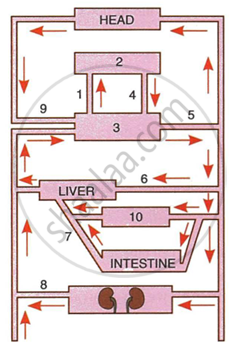Advertisements
Advertisements
Question
The diagram below represents the simplified pathway of the circulation of blood. Study the same and answer the questions which follow:

(i) Name the blood vessels labelled 1 and 2.
(ii) State the function of blood vessels labelled 5 and 8.
(iii) What is the importance of the blood vessel labelled 6?
(iv) Which blood vessel will contain a high amount of glucose and amino acids after a meal?
(v) Draw a diagram of the different blood cells as seen in a smear of human blood.
Solution
(i)
1– Superior vena cava
2 – Aorta
(ii) Function of blood vessel 5 (Hepatic artery) – It supplies oxygenated blood to the liver.
Function of blood vessel 8 (Inferior vena cava) – It carries deoxygenated blood from the posterior parts of the body to the heart.
(iii) Importance of blood vessel 6 (Hepatic portal vein) – It carries nutrient laden blood from the gastrointestinal tract to the liver.
(iv) Blood vessel 6, i.e. hepatic portal vein.
(v) Different blood cells seen in a smear of human blood:

RELATED QUESTIONS
The exact location of the tricuspid valve
Give appropriate biological or technical terms for the following
The relaxation phase of the heart.
Differentiate between members of the following pairs with reference to the aspect asked within bracket:
Artery and vein (direction of blood flow)
Given below is a highly schematic diagram of the human blood circulatory system.
 |
- Which part (state the number) represents the heart? Give reason in support of your answer.
- Which numbers represent the following, respectively?
Aorta Superior vena cava Hepatic portal vein Renal Vein Pulmonary artery Stomach
pH of oxygenated blood is ______.
Multiple choice questions. Tick ( ✓ ) the correct choice:
The four blood groups in humans are
Define the: Arteries
Match the following.
| Group A | Group B |
| (1) Lungs | (a) Circulation |
| (2) Stomach | (b) Respiration |
| (3) Heart | (c) Co-ordination |
| (4) Brain | (d) Digestion |
______ refers to a marked decrease in the number of platelets.
Name these:
Three components of circulatory system.
